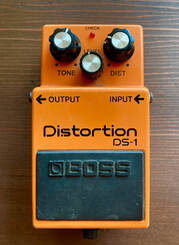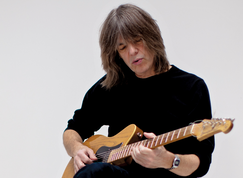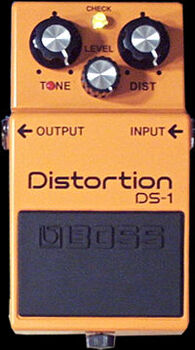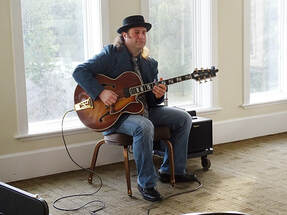A Brief History of Grime: A quick look at famous DS-1 Modifications
By Robert Witmeyer (Blue Skool Records)
What do grunge legend Kurt Cobain, shredder Steve Vai, bluesman Gary Moore, virtuoso Joe Satriani, jazz head Mike Stern, and Chili Pepper John Frusciante all have in common?
|
Unlikely as it may seem, all of these musical heroes achieved epic guitar tones using the modest Boss DS1 Distortion Pedal. Released by Boss in 1978, the DS1 continues to be a go-to dirt box for many touring musicians, as well as bedroom strummers alike. Despite the continued popularity of this orange box, many have legitimate critiques of this stompbox and it's shortcomings. Born out of desire to fix these perceived shortcomings, the boutique trend of "modding" - or, modifying the existing circuit to create an end product that is more musical, less noisy, more versatile, and sounds more like an amp in a box - was born.
|
(For a guide to understanding pedal components view our article "Demystifying the science behind effects pedals")
Two of the most popular DS1 mods come from boutique legends Robert Keeley and Brian Wampler.
|
Most are familiar with Keeley's "Seeing Eye Mod," which consists of five capacitor swaps and three resistor changes, along with altering the clipping diodes. The end result is a much more "open" sounding pedal, with more usable throw on the tone control and amp-like clipping. The main change that players can hear (and see!) is the "Seeing Eye" clipping LED (light emitting diode). By changing the traditional silicon clipping diodes to a combination of a LED and silicon diode, the pedal achieves asymmetrical clipping with 2nd order harmonics, and the LED lets more mids, (read: meat) and other tones through for a more realistic "Wall of Marshalls" sound. Visually, as the signal is run through the LED for clipping, the sonic signal causes the light (LED) to illuminate in harmony with the player's dynamic strumming, making for a cool visible effect that compliments the tonal changes that accompany this popular mod.
|
Taking it to the Next Level
Released in 2002, Brian Wampler's book, How to Modify Pedals, featured nummerable mods for various pedals, from the Big Muff Pi, to Danelectro's Fabtone. Included in Wampler's DIY guide were various suggestions for taking the tone of the DS1 to new levels. Instead of just one mod, Wampler offered up many suggestions to achieve a variety of textures from metal to bluesy, and the book included instructions for: The Evil Mod, Classic Rock Mod, Acid Blues Mod, Tube Emulator Mod, Vintage Mod, JCM Mod, Modern Mod, and the "less shrill" mod. Much like the above-mentioned Keeley mod, Wampler's changes involve swapping out capacitors, resistors, and clipping diodes to access all the best tone with less noise and thizz.
Back to Skool
We formed Blue Skool Records (a boutique pedal building institution in Los Gatos, CA) in order to provide unique hand built pedals and custom pedal mods. We have spent countless hours researching popular mods in order to find the optimal configurations. By studying these mods closely, we were able to find similarities across the many suggestions available, and used the information to create an original DS1 Mod that takes the best of all the mentioned changes, leaving out the tweaks that made little to no difference in the end product. The result is an extremely versatile mod that offers players a diverse cornucopia of tones from subtle blues overdrive, to face melting shred, and everything in between. Like the Keeley mod, our Blue Skool Mod features asymmetrical clipping with an LED that lights when the signal clips. Along with a change in clipping diodes, our Blue Skool mod also features lots of meaty tone, no shrill highs, more gain when the knob is dimed, and less gain with control all the way down. Finally, the Blue Skool mod is more than half as quiet as the original DS1, and offers a whole slew of usable tones for players to choose from.
If you are interested about any of the aforementioned Mod's or would like to talk shop give us a call at (408)-395-0767 or email us at [email protected]
Obsessed with building and modding pedals for the past 10 years, Robert Alan Witmeyer is a local professional musician and multi-instrumentalist in the South Bay Musical Community. He received his first pedal as a gift during high school, and instantly became a pedal addict. While Witmeyer recently won the KFOX Riff Off, earning him the title of "Best (unsigned) Guitarist in the SF Bay Area", he is also proficient on 163 other instruments including piano, bass, mandolin, banjo, vibraphone, organ, and various percussion. After releasing multiple albums on itunes, amazon, spotify, etc, Robert found his live tone lacking, and began researching what big name acts did to achieve their legendary tone. Upon learning about the art of "modding", Witmeyer began altering all his pedals, and later, started building his own effects using his label name, Blue Skool Records. Throughout the years, Blue Skool worked with other companies to create unique circuits, including designing and promoting an original Fuzz and Octavia pedal, mini Amp, and other circuits for Peacekeeper Guitars at the infamous NAMM show. As a music journalist, Robert reviewed pedals for Guitar Player magazine, and was a contributing writer with pedals as his forte. Today, Blue Skool Record's stompboxes are on the boards of many local pros including Simon Santiago (the Houserockers), Rome Yamilov (Aki Kumar Band), and Jim Thomas (The Mermen).




